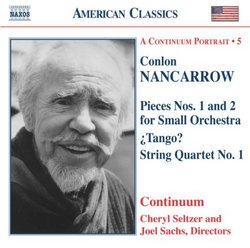| All Artists: Conlon Nancarrow, Joel Sachs, Continuum, Cheryl Seltzer Title: Nancarrow: Pieces Nos. 1 & 2; ¿Tango?; String Quartet No. 1 Members Wishing: 1 Total Copies: 0 Label: Naxos American Release Date: 6/21/2005 Genres: International Music, Special Interest, Classical Styles: Latin Music, Tango, Chamber Music, Forms & Genres, Sonatas, Historical Periods, Classical (c.1770-1830), Modern, 20th, & 21st Century, Instruments, Strings Number of Discs: 1 SwapaCD Credits: 1 UPC: 636943919620 |
Search - Conlon Nancarrow, Joel Sachs, Continuum :: Nancarrow: Pieces Nos. 1 & 2; ¿Tango?; String Quartet No. 1
 | Conlon Nancarrow, Joel Sachs, Continuum Nancarrow: Pieces Nos. 1 & 2; ¿Tango?; String Quartet No. 1 Genres: International Music, Special Interest, Classical
|
Larger Image |
CD Details |
CD ReviewsNancarrow without the player piano: an essential addition to Discophage | France | 10/31/2007 (5 out of 5 stars) "This is the reissue of a recording made in 1989 and first released in 1991 by Musicmasters. See my lengthy review under the original release (Continuum Performs Nancarrow). It is an essential addition to our knowledge and understanding of Nancarrow, as it documents most of the (very few) pieces he wrote for for "normal" instruments, e.g. live performers, as opposed to the mechanical player piano for which he belatedly became so famous. Other than, perforce, the pieces he composed subsequently to the present recording (such as the Canons for Ursula Oppens or the third String Quartet), absent are the two remaining movements of the early (1942) Trio for Clarinet, Bassoon and Piano whose first movement is featured here: they were considered lost and were rediscovered shortly after the recording was made.
It is also best heard in company of Conlon Nancarrow : Lost Works, Last Works published by Other Minds, which in part documents the transcriptions for Player Piano that Nancarrow made of some of these compositions, just in order to be able to hear them (they were nearly unplayable by human performers, and anyway he lived in Mexico, isolated from the music world): the "Prelude", "Blues", Sonatina, the two outer movements of the String Quartet and, much later, the second part of the Piece for Small Ensemble No. 2 (Study # 50). The difference is not only the obvious one of timbre (especially in the Quartet and Piece for Ensemble), but also, dramatically, of tempo. One understands what Nancarrow had in his "mind's ear" when composing these pieces and hence, why he grew dissatisfied with human performers. The String Quartet played on four strings sounds like, well, just any other string quartet, one that possibly Milhaud (the dynamic bounce, the polytonal impression) or Krenek (the stern canons) and many other 20th century composers of mildly modernist ilk might have written. It its player piano transcription, it sounds like a dazzling, demented study for machine-keyboard. Still, in their version for live performers the pieces are echt-Nancarrow, full of the customary awesome canons and demented boogie-woogies. Other than original Nancarrow compositions, the disc also features two transcriptions made by Yvar Mikhashoff: the Sonatina, originally for one piano and here played on piano four-hands (a version Nancarrow reportedly came to prefer, even over his own player piano transcription), and player piano Study # 15. And while pianists Cheryl Seltzer and Joël Sachs (who joins her in the four-hand pieces) are no match to the machine in the Prelude, Blues and Sonatina, their fingers are still quite impressive for human appendixes and make a convincing case for the pieces in "live form". It is even a tribute to the two pianists' awesome virtuosity that in Study # 15, they do match the machine. Gary Kasparov is not alone to face Deep Blue. My only regret have is that each piece individually is so short, as well as the disc overall (44:36). But at Naxos' prices, this is not detrimental. " |

 Track Listings (13) - Disc #1
Track Listings (13) - Disc #1